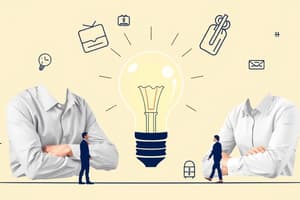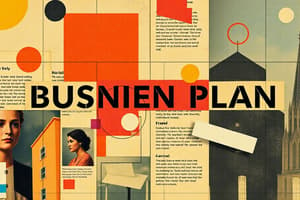Podcast
Questions and Answers
What is creativity defined as?
What is creativity defined as?
- The tendency to generate or recognize ideas, alternatives, or possibilities (correct)
- The ability to solve problems
- The ability to recognize new ideas
- The ability to generate new ideas
Creativity is only an attitude and not a skill that can be improved with practice.
Creativity is only an attitude and not a skill that can be improved with practice.
False (B)
What are the three reasons why people are motivated to be creative?
What are the three reasons why people are motivated to be creative?
Need for novel, varied, and complex stimulation, need to communicate ideas and values, and need to solve problems
The creative process involves assembling ideas by recombining elements already known but wrongly assumed to be __________________________.
The creative process involves assembling ideas by recombining elements already known but wrongly assumed to be __________________________.
Match the following characteristics of creative thinking with their descriptions:
Match the following characteristics of creative thinking with their descriptions:
What is the outcome of the creative process?
What is the outcome of the creative process?
Tests of creativity only measure the number of alternatives that people can generate.
Tests of creativity only measure the number of alternatives that people can generate.
What is the development of ideas about products, practices, services, or procedures that are novel and potentially useful to the organization?
What is the development of ideas about products, practices, services, or procedures that are novel and potentially useful to the organization?
What is the definition of risk?
What is the definition of risk?
What is the second stage of the creative process?
What is the second stage of the creative process?
Entrepreneurship is the same as innovation.
Entrepreneurship is the same as innovation.
What is the main difference between creativity and innovation?
What is the main difference between creativity and innovation?
Innovation is the generation of new ideas.
Innovation is the generation of new ideas.
What is the term for the problem-conquering solution that flashes into a person's mind at an unexpected time?
What is the term for the problem-conquering solution that flashes into a person's mind at an unexpected time?
Entrepreneurship is the result of a disciplined, systematic process of applying ____________ and ____________ to needs and opportunities in the marketplace.
Entrepreneurship is the result of a disciplined, systematic process of applying ____________ and ____________ to needs and opportunities in the marketplace.
What do researchers believe is the key to entrepreneurs' success?
What do researchers believe is the key to entrepreneurs' success?
The barrier to creativity that involves being overly cautious and avoiding risks is called _______.
The barrier to creativity that involves being overly cautious and avoiding risks is called _______.
Match the following concepts with their definitions:
Match the following concepts with their definitions:
Match the following personality traits with their descriptions:
Match the following personality traits with their descriptions:
Entrepreneurship is the same as creativity.
Entrepreneurship is the same as creativity.
Creativity is the same as innovation.
Creativity is the same as innovation.
What is the stage of the creative process where the individual sets out to prove that the creative solution has merit?
What is the stage of the creative process where the individual sets out to prove that the creative solution has merit?
What is the role of entrepreneurs in the marketplace?
What is the role of entrepreneurs in the marketplace?
What is the term for the process of intentional change made to create value by meeting opportunity and seeking advantage?
What is the term for the process of intentional change made to create value by meeting opportunity and seeking advantage?
What is the primary purpose of entrepreneurship in terms of value creation?
What is the primary purpose of entrepreneurship in terms of value creation?
Innovation is a predictable and planned process.
Innovation is a predictable and planned process.
What is the definition of synthesis in terms of innovation?
What is the definition of synthesis in terms of innovation?
The process of entrepreneurship involves identifying opportunities and turning them into ___________ insights.
The process of entrepreneurship involves identifying opportunities and turning them into ___________ insights.
Match the following types of innovation with their descriptions:
Match the following types of innovation with their descriptions:
What is the fourth stage of the innovation process?
What is the fourth stage of the innovation process?
Creativity in entrepreneurship relies on dreams and blue-sky ideas.
Creativity in entrepreneurship relies on dreams and blue-sky ideas.
What is the primary focus of the entrepreneurial process?
What is the primary focus of the entrepreneurial process?
What is the origin of the word "entrepreneur"?
What is the origin of the word "entrepreneur"?
According to Richard Cantillon, entrepreneurs earn fixed incomes.
According to Richard Cantillon, entrepreneurs earn fixed incomes.
What is the primary characteristic of an entrepreneur according to David McClelland?
What is the primary characteristic of an entrepreneur according to David McClelland?
An entrepreneur searches for ______________ and exploits opportunities according to Peter Drucker.
An entrepreneur searches for ______________ and exploits opportunities according to Peter Drucker.
Match the following definitions of entrepreneurship with their respective authors:
Match the following definitions of entrepreneurship with their respective authors:
What is the term used by Schumpeter to describe the process of innovation in entrepreneurship?
What is the term used by Schumpeter to describe the process of innovation in entrepreneurship?
According to Frank H. Knight, entrepreneurship is about playing it safe.
According to Frank H. Knight, entrepreneurship is about playing it safe.
What is the primary role of an entrepreneur according to Jean-Baptiste Say?
What is the primary role of an entrepreneur according to Jean-Baptiste Say?
Flashcards are hidden until you start studying
Study Notes
Creativity and Innovation in Entrepreneurship
What is Creativity?
- Creativity is the ability to generate or recognize ideas, alternatives, or possibilities that may be useful in solving problems, communicating with others, and entertaining ourselves and others
- It is a process of assembling ideas by recombining elements already known but wrongly assumed to be unrelated to each other
- Creativity results in ideas that have potential value
- Three reasons why people are motivated to be creative:
- Need for novel, varied, and complex stimulation
- Need to communicate ideas and values
- Need to solve problems
The Creative Process
- Opportunity or Problem Recognition: A person discovers that a new opportunity exists or a problem needs resolution
- Immersion: The individual concentrates on the problem and becomes immersed in it
- Incubation: The person keeps the assembled information in mind for a while
- Insight: The problem-conquering solution flashes into the person's mind at an unexpected time
- Verification and Application: The individual sets out to prove that the creative solution has merit
Personality Traits of Creative People
- Persistence
- Self-confidence
- Independence
- Attraction to complexity
- Tolerance of ambiguity
- Intuitiveness
- Having broad interests
- Being energetic
- Drive to achieve
- Loving their work
- Taking risks
Barriers to Creativity
- Excessive focus on extrinsic motivation
- Limits set by superiors
- Critical evaluation
- Close, controlling supervision
- Competition in a win-lose situation
- Control of decision making
- Control of information
- Blindly following the rules
- Constantly being practical
- Fearing looking foolish
- Fearing mistakes and failure
Innovation
- Innovation is the implementation of new ideas at the individual, group, or organizational level
- It is a process of intentional change made to create value by meeting opportunity and seeking advantage
- Innovation is the ability to apply creative solutions to problems and opportunities
Entrepreneurship
- Entrepreneurship is the result of a disciplined, systematic process of applying creativity and innovation to needs and opportunities in the marketplace
- Entrepreneurship is the combination of creativity and innovation
- Entrepreneurs are those who marry their creative ideas with the purposeful action and structure of a business
Types of Innovations
- Invention: The creation of a new product, service, or process
- Extension: The expansion of an existing product, service, or process
- Duplication: Copying (replicating) an existing product or service and then adding the entrepreneur's own creative touch
- Synthesis: A combination of more than one existing product or service into a new product or service
The Innovation Process
- Analytical planning: Carefully identifying the product or service features, design, as well as the resources that will be needed
- Resource organization: Obtaining the required resources, materials, technology, human or capital resources
- Implementation: Applying the resources in order to accomplish the plans
- Commercial application: The provision of value to customers, reward employees, and satisfy the stakeholders
Myths of Innovation
- Innovation is planned and predictable
- Technical specifications should be thoroughly prepared in advance
- Creativity relies on dreams and blue-sky ideas
- Big projects will develop better innovations than smaller ones
- Technology is the driving force of innovation and success
Entrepreneurship Theories
- Richard Cantillon: Entrepreneurs are non-fixed income earners who pay known costs of production but earn uncertain incomes
- Jean-Baptiste Say: An entrepreneur is an economic agent who unites all means of production and thus produces a product
- David McClelland: An entrepreneur is a person with a high need for achievement [N-Ach]
- Peter Drucker: An entrepreneur searches for change, responds to it, and exploits opportunities
- Schumpeter: Entrepreneurs are innovators who use a process of shattering the status quo of the existing products and services
- Frank H. Knight: Entrepreneurship is about taking risk
Studying That Suits You
Use AI to generate personalized quizzes and flashcards to suit your learning preferences.




